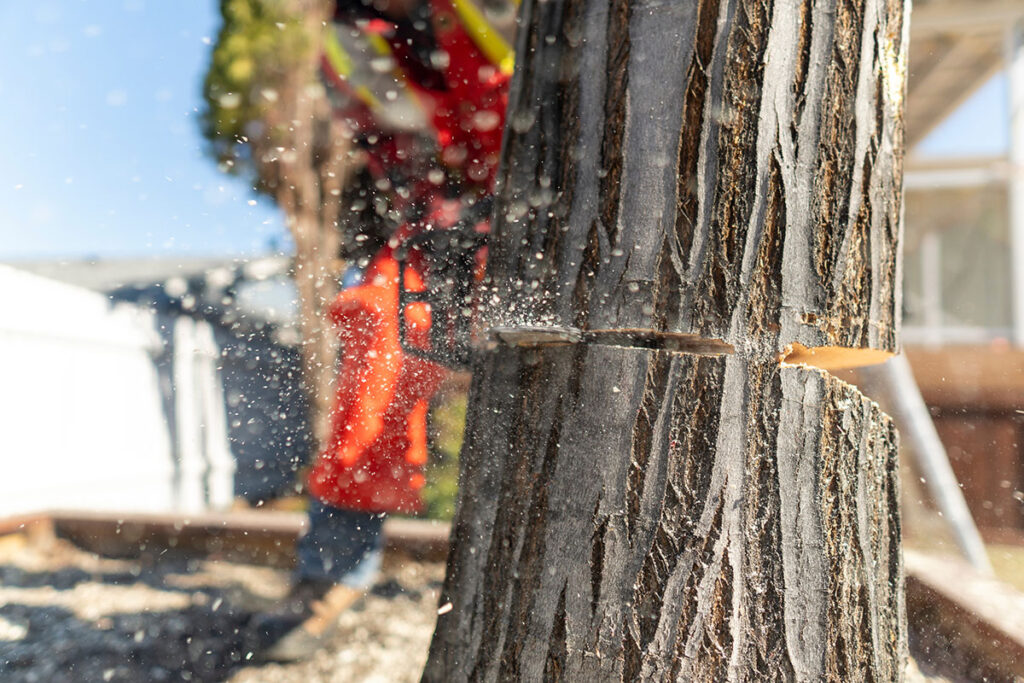While the oldest living tree is over 5,000 years old, the trees on your property might not have as much life in them. And if you don’t do anything about a decaying tree, you risk damaging neighboring buildings or passersby. The better choice is to be alert to problems and take action.
Curious to learn more? Read on to learn the 7 signs you may want to consider tree removal!
1. Close Proximity to Powerlines
You’ll want to contact a tree removal service if you have tree branches that interfere with powerlines. While it may not be necessary to remove the entire tree, it will make sense to trim some branches.
Not trimming branches may lead to interference, especially during storms. As a result, you or your neighbors could be more likely to encounter power outages. Worse yet, powerlines entangled with trees can trigger sparks and cause a fire.
Don’t try doing the trimming yourself, either. You risk exposing yourself to high voltages that can burn you or falling off a ladder. You’re much better off turning to a good tree removal service.
2. Hollow Cavities Indicate Health Problems
Have you noticed cavities in your tree? This could mean that your tree is on the path toward decay. You may notice mushrooms or fungi springing, as well.
When you have cavities, be aware that insects and pests may be taking up residence inside of them. Left untreated, these pest problems can start infecting other trees nearby, too. Your best bet is to pursue tree removal to spare yourself from unwanted guests and other damaged trees!
3. A Leaning Tree Can Be Dangerous
Trees that aren’t upright might be in danger of falling. If you notice one of the trees on your property leaning more than 15% beyond a 90-degree angle, call the professionals. A trained arborist can tell you if the lean is normal, such as with a live oak tree — or problematic.
Leaning trees may have weakened roots. And it could just take a gust of wind or storm for the tree to fall. If you have a house or business in the path of the leaning tree, don’t delay taking action.
4. Remove Storm-Damaged Trees
If a strong summer storm passed through your area, it’s worth doing a search for tree removal near me. Your tree might look like it weathered the storm. But don’t be so sure.
Shredded leaves or missing bark are common visible signs that a storm has impacted your tree. If your tree had other health issues before the storm, however, it might be more damaged than you think.
For instance, if your tree had a faulty or weakened root system, high winds and rain could have made things worse. Weakened roots mean your tree is more likely to fall. And since future storms are likely, it’s worth taking a closer look.
You also should look for new cracks in your tree’s trunk. These can be a result of high winds. And if your area has flooded, the soil levels and nutrients may have taken a hit, leaving your tree less secure.
5. Rotting Roots Cause Structural Issues
Root rot is another issue to be on the lookout for on your property. Particularly if you’ve received a lot of heavy rain, you might have too much water in the soil around your trees. In this scenario, your roots can’t get the oxygen they need because of the excess water.
Saturated soil also means that your roots can’t get lots of essential nutrients. While root rot can be hard for the average person to see, you can see the impact on the rest of the tree. Thin branches, small leaves, and cankers are visible indications that you need a tree removal service to inspect further.
6. Watch for Brittle Bark
Take a closer look at the bark on the trees on your property. Normally, bark will look thick and plentiful. But if you see bare spots or peeling bark, you may have a reason for tree removal.
Peeling or brittle bark indicates internal problems. Your tree’s bark also could look dry, brown, and flaky. You can try doing a scratch test to see if the layer beneath the bark is a verdant green.
If the layer isn’t green and is brown, you might be dealing with a dead tree. Drought conditions, fungi, and a lack of nutrients can contribute to brittle bark. Work with a trained arborist to see if you can nurse your tree back to health or not.
7. Trees May Obstruct Critical Views
Do you have a tree that obstructs an important view? A tree that prevents you from seeing traffic as you exit your property can be dangerous. You run the risk of causing accidents and could be held liable.
Consider removing some limbs as a first effort. But you may be better off removing the tree and planting one scaled more appropriately to the property, however.
Similarly, trees that block views of pedestrians can make walkways more dangerous. And tree roots that have disrupted sidewalk pavement can cause tripping or falls. Be sure to reinforce sidewalks as needed or spraypaint bright colors to alert walkers to uneven areas.
Look into Tree Removal
Tree removal can be an essential choice when you have a dead tree or one that’s not healthy. Look for visible problems, like brittle bark or roots that are deteriorating. And if you have a tree that prevents clear views or sits close to powerlines, you might be better removing it.
Ready to take care of the damaged trees on your property? Contact us and we can help!
